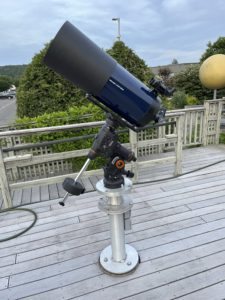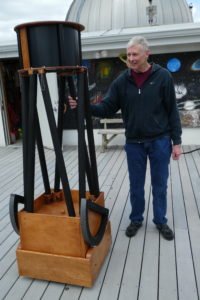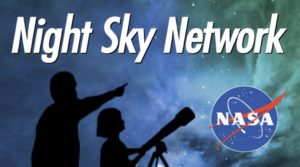About the John J. McCarthy Observatory
“Opening the Universe to all”
The John J. McCarthy Observatory is a world-class astronomical observatory (International Astronomical Union code 932) located on the campus of the New Milford High School, on Route 7 in New Milford Connecticut.
It is a state-of-the-art educational and research facility. It is open to all: students, community groups, the general public, educators, and researchers with no charge for its use. The facility is equipped with complete accessibility for the disabled, including a lift for wheelchair users, voice activated telescope control software, and a flexible eyepiece extender.
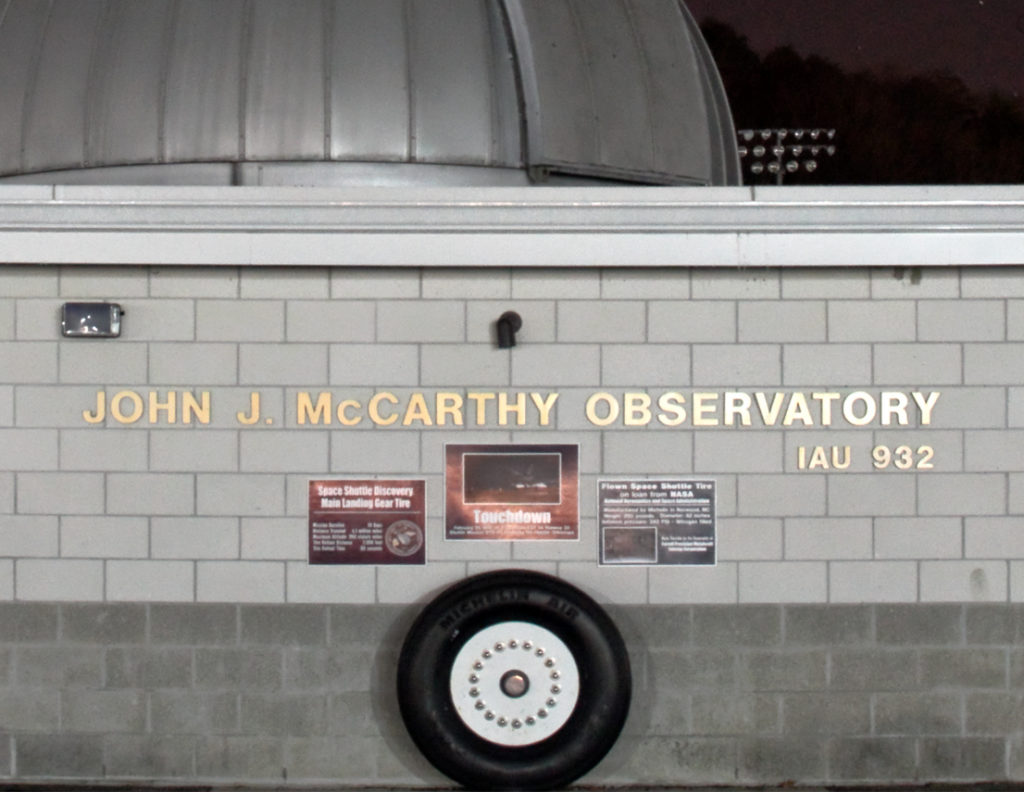
The Telescopes
A rich and growing set of instruments for your use
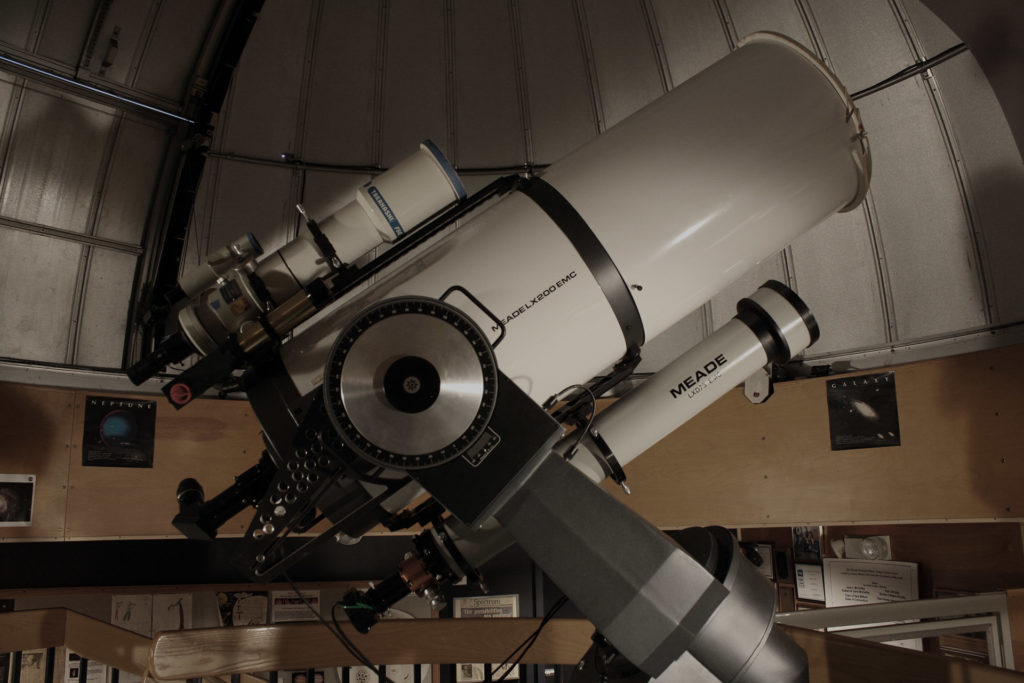
The primary instrument used at the McCarthy Observatory is a 16″ Meade Schmidt Cassegrain telescope on an equatorial mount. Installed in 2000, and donated by the Ellen Knowles Harcourt Foundation, it has been a real workhorse of science and celestial exploration for our visitors. With this device, a student won the Intel International Science Fair, asteroids have been discovered, and many hundreds of observations of potentially hazard space objects have been accurately observed for science purposes.
Also mounted on the Meade mount system with the Harcourt telescope is a wonderful wide field 106mm Takahashi refracting telescope, a 5″ Meade refractor, and a Coronado solar telescope for observing detail on solar activity safely. We also have a 90mm Coronado solar filter set for higher contrast viewing of solar events.
The observatory also has a wonderful set of other telescopes for imaging, science use, and public event use on our outdoor Sky Deck. Key among these are 7″ and a 3.5″ Questar Maksutov-Cassegrain telescopes, a 14.5″ truss-tube Dobsonian, and an 10 inch Meade Schmidt-Cassegrain device. There is also a growing population of other donated equipment. The main telescope systems are computer-controlled and automated for rapid acquisition of target celestial objects, with high quality mounts and tracking software. The observatory has acquired an excellent set of fine eyepieces to fit all these telescopes and to meet the needs of the range of objects and seeing conditions that our visitors counter.
Special mention should be made of the superb collection of telescopes owned by the volunteers, who eagerly bring them to events and help our visitors observe through them and learn how to operate them. This collection is growing rapidly as volunteers work on fabricating their own mirrors and telescopes – at least six mirrors are now completed or in the process of finishing at this time.
Imaging of galaxies, nebula, planets, asteroids, the moon, and comets is done regularly by staff and users of the observatory, on state-of-the-art equipment. Both scientific investigation and “capturing the magnificence of the heavens” is possible with the imaging equipment at your disposal.
- The list of cameras and accessories in use includes:
- An SBIG ST10-XME camera and filter wheel
- An SBIG ST7 camera and filter wheel
- An SBIG Spectrograph and an ST7 camera attached
- A full set of Astrodon professional grade narrow band and color filters in a filter wheel
- An SBIG STV camera for tracking and imaging
- A ZWO ASI 120mc video camera
- A AmScope MU1803 Microscope Digital Camera for use with the meteorite microscope
Each of these cameras can be attached to any of the telescopes at the facility, including being mounted on the outside deck, with feeds going to any other location in the observatory and to many storage or display devices.
Imaging and Science Equipment
Capturing photons over the light years
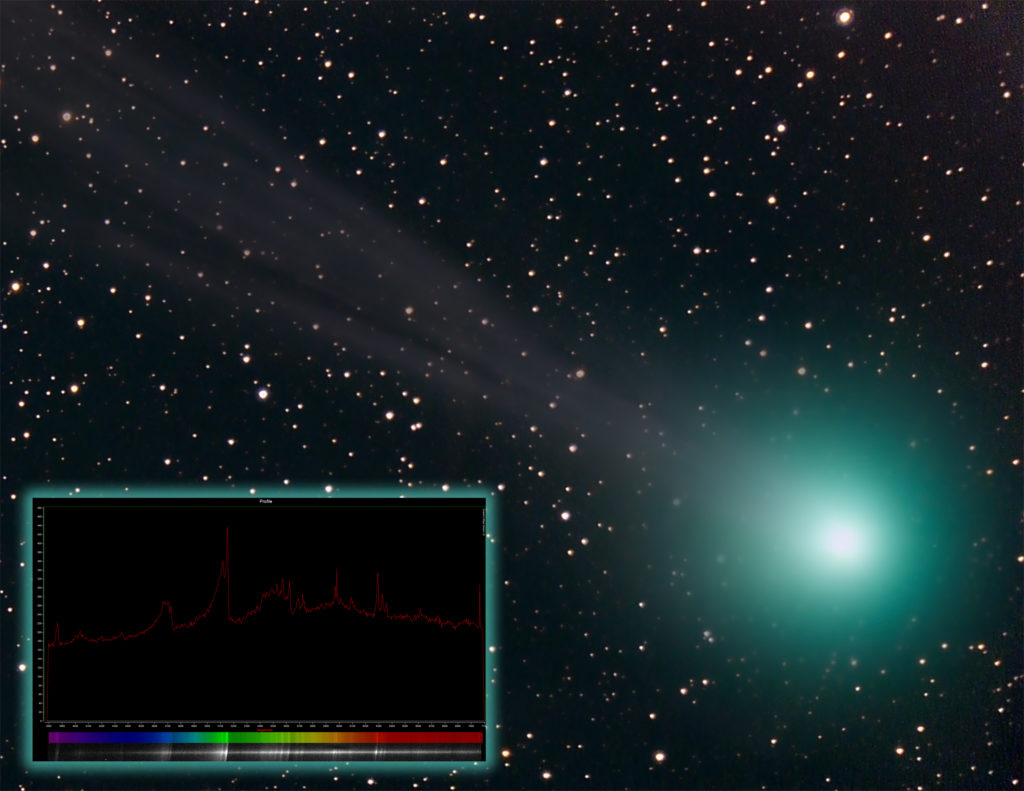
Technology
Keeping up with the latest innovations to evolve our capabilities

The technology deployed at the observatory is always evolving, as new needs and new systems capability arise. The volunteer team works closely with the New Milford School System staff to make sure we have the latest technology and are in compliance with the school system policies for network management, security, and appropriate use.
Currently there are three main user computers in regular use: one for telescope and camera control, one for administration, and one for education, image manipulation, simulators, etc. These are all tied via a gigabit network to a Network Attached Storage device that has four terabytes of space used for archiving and large image files. In addition, there is a laptop for mobile teaching purposes, supporting our “Astronomy To Go” program for visiting regional schools. Wifi capability is also available throughout the facility
Accurate time management is an imperative for astronomical science, particularly in astrometry, so it receives strong attention at this Observatory. We are currently utilizing a Raspberry Pi running a real-time Linux kernel using the pulse per second output of a GPS receiver mounted on the observatory roof to maintain under 5 microsecond accuracy as a Stratum 1 time source.
Accurate current weather information is captured and stored from a Davis weather station, and it is displayed on the observatory website, along with a “Clear Sky Chart” that predicts cloud conditions, seeing conditions, and atmosphere transparency for two days. We have found it to be a very useful guide for observation event planning. We also have a registered New Milford weather site on Weather Underground that has current and comprehensive weather information and history for our locale.
The telescopes and cameras are robotically controlled by The Sky6 software from Software Bisque. Many other software packages are in use for image manipulation, session planning, image stacking, photometry, astrometry, etc.
The observatory is fully wired with CAT5e cable throughout, including all the piers on the outside deck, and links to the school system network and the outside world include 50 pairs of telephone wire and 12 fiber optic cable (6 multimode, 6 single mode). We are able to produce live broadcasts to the local cable network, with pristine signal quality.
In the control room, there is a projection system for educational and group project purposes, linked though switches so that any computer or signal source can be linked to the projector, wherever it may be deployed in the facility or on the outside event deck.
The outside deck has four telescope piers and adapters for many many popular telescope mounts. Each pier has power and signal connectors, with signal linked to the main network switch.
The McCarthy Observatory facility consists of several main sections:
- The main observing deck – under a 16 foot dome is housed a main telescope stack mounted on an equatorial pier and computer driven mount system. Behind that is a lift system that allows wheelchair users to access the telescopes. A curved staircase allows access and egress for visiting groups. Computer monitors and camera monitors are on the deck for control and image viewing by visitors. Computer controlled dome rotation, camera control focus control and filter selection can all be done from the deck or from the control room.
- The control room/classroom – adjacent to the observing deck is a combination of a small classroom, the technology center, a lending library, and the control computers on a work counter. All computers are linked to a server, and to an overhead projector that allows us to project on a screen at the end of the room for visitors, classes, and project work.
- Storage areas under the deck and in a storage room adjacent to the restroom for telescopes, accessories and educational support materials.
- The 1,000 square foot outdoor observing deck, with four telescope piers and light blinds to give visitors a “dark sky” experience during our star party events,
- The 3,000 square foot “Galileo’s Garden” adjacent to the outdoor deck, with many benches for visiting groups.
The entire facility is wired with ethernet cable and power outlets within easy reach. Twelve fiber-optic cables provide connection to the school and outside world for internet connection and video productions.
Other facility features include a weather station, a very accurate GPS-driven time management system, and a satellite dish that receives the NASA station transmissions, which can be broadcast from the observatory. The entire observatory and outside areas are fully ADA compliant.
Your Observatory Facility
Built and operated by dedicated volunteers
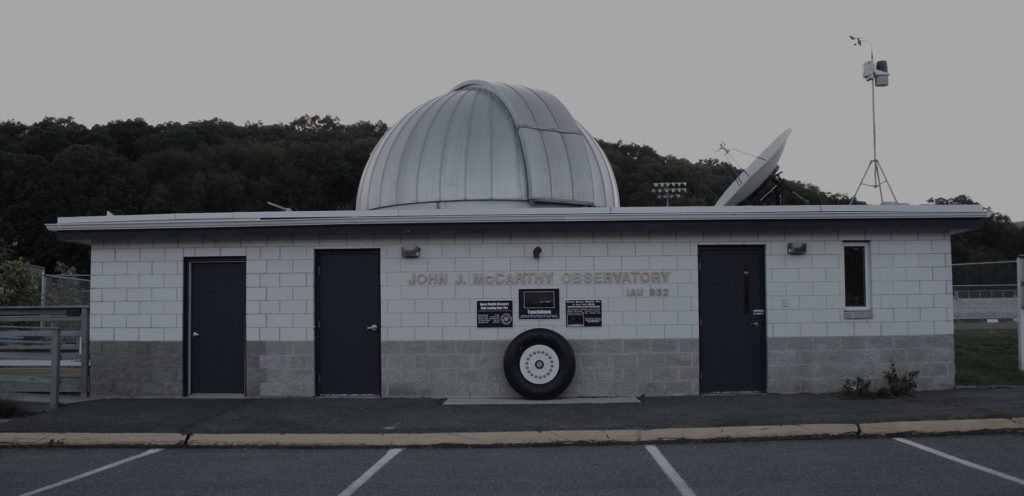
Artifact Collection
An ever growing collection of space-related items
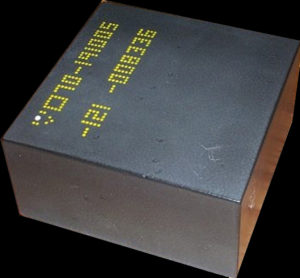
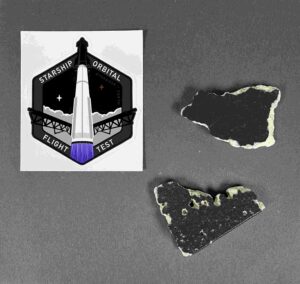
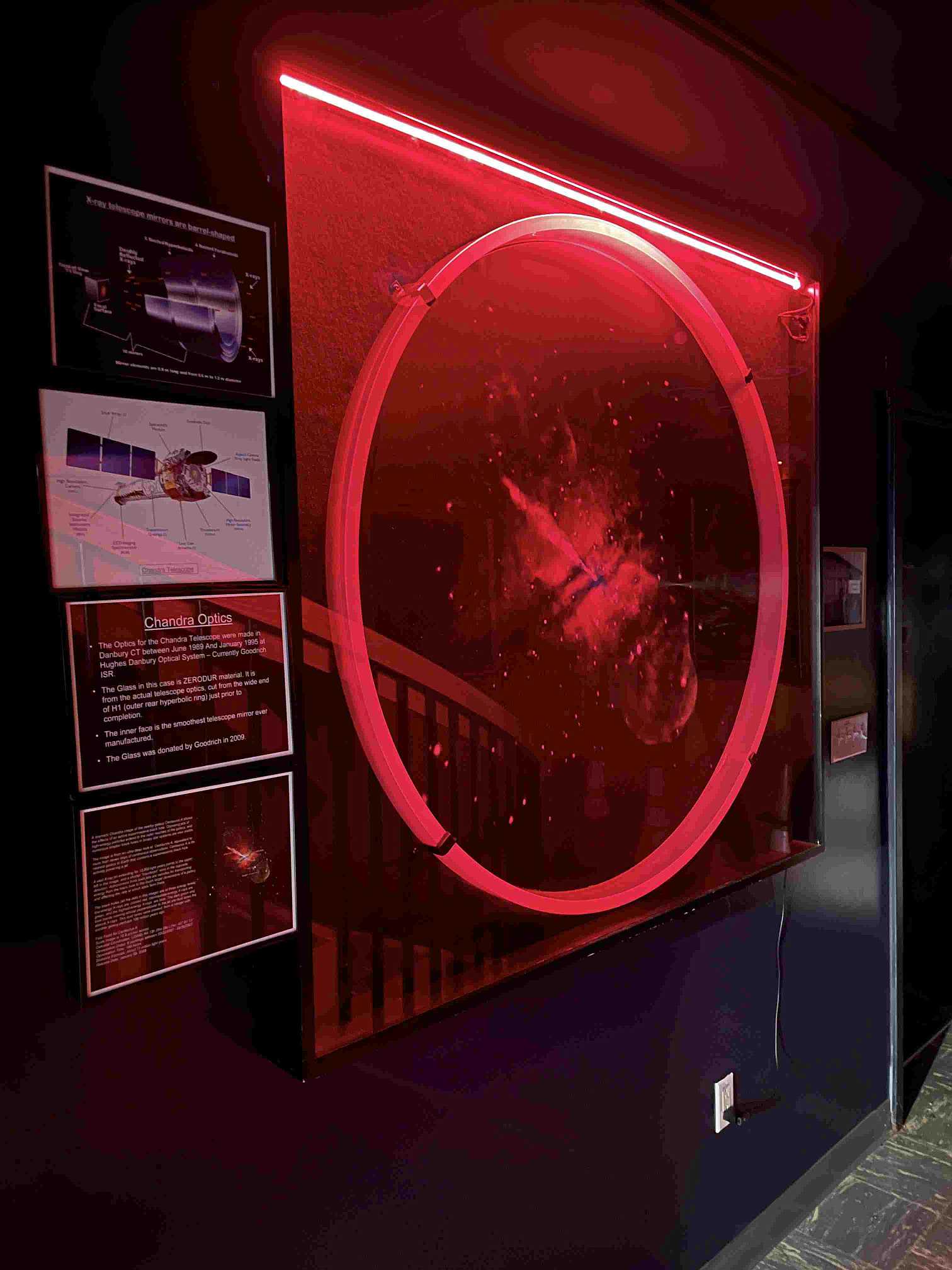
As a member of the NASA Museums Alliance and as part of the New Milford Public School System, the Observatory is eligible to apply for receipt of space artifacts when space programs are terminated. We also have been fortunate to receive donated artifacts from Goodrich in Danbury, with whom we have a close association, and from various private donors over time.
Included in the artifacts collection at present:
- A flown Space Shuttle main landing gear tire for a mission to the Hubble telescope in 1997 (STS-82)
- A slice of the actual mirror system of the Chandra X-ray telescope
- Two shuttle heat-shield tiles – one high-temperature (<2,300°F) with black borosilicate coating and one low-temperature (<1,200°F) white silica tile
- A large collection of meteorites, including one that is older than the solar system
- A very large NASA “museum-quality” mural set of composite images of Spiral Galaxy M101
- A second flown Space Shuttle main landing gear tire, complete with rim and brake drum for the Return to Flight in 2005 (STS-114)
- Two heat shield fragments from SpaceX Starship 24 test launch
The Observatory is a member of NASA’s Night Sky Network:
The Night Sky Network is a nationwide coalition of amateur astronomy clubs bringing the science, technology, and inspiration of NASA’s missions to the general public. We share our time and telescopes to provide you with unique astronomy experiences at science museums, observatories, classrooms, and under the real night sky. Click on the image at right to visit the Night Sky Network.

